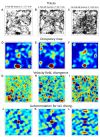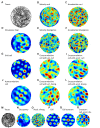Navigation Patterns and Scent Marking: Underappreciated Contributors to Hippocampal and Entorhinal Spatial Representations?
- PMID: 29922134
- PMCID: PMC5996749
- DOI: 10.3389/fnbeh.2018.00098
Navigation Patterns and Scent Marking: Underappreciated Contributors to Hippocampal and Entorhinal Spatial Representations?
Abstract
According to the currently prevailing theory, hippocampal formation constructs and maintains cognitive spatial maps. Most of the experimental evidence for this theory comes from the studies on navigation in laboratory rats and mice, typically male animals. While these animals exhibit a rich repertoire of behaviors associated with navigation, including locomotion, head movements, whisking, sniffing, raring and scent marking, the contribution of these behavioral patterns to the hippocampal spatially-selective activity has not been sufficiently studied. Instead, many publications have considered animal position in space as the major variable that affects the firing of hippocampal place cells and entorhinal grid cells. Here we argue that future work should focus on a more detailed examination of different behaviors exhibited during navigation to better understand the mechanism of spatial tuning in hippocampal neurons. As an inquiry in this direction, we have analyzed data from two datasets, shared online, containing recordings from rats navigating in square and round arenas. Our analyses revealed patchy navigation patterns, evident from the spatial maps of animal position, velocity and acceleration. Moreover, grid cells available in the datasets exhibited similar periodicity as the navigation parameters. These findings indicate that activity of grid cells could affect navigation parameters and/or vice versa. Additionally, we speculate that scent marks left by navigating animals could contribute to neuronal responses while rats and mice sniff their environment; the act of sniffing could modulate neuronal discharges even in virtual visual environments. Accordingly, we propose that future experiments should contain additional controls for navigation patterns, whisking, sniffing and maps composed of scent marks.
Keywords: chicken or egg dilemma; grid cells; head direction cells; hippocampal formation; navigation behavior; place cells; scent marking.
Figures


Similar articles
-
A novel somatosensory spatial navigation system outside the hippocampal formation.Cell Res. 2021 Jun;31(6):649-663. doi: 10.1038/s41422-020-00448-8. Epub 2021 Jan 18. Cell Res. 2021. PMID: 33462427 Free PMC article.
-
RatInABox, a toolkit for modelling locomotion and neuronal activity in continuous environments.Elife. 2024 Feb 9;13:e85274. doi: 10.7554/eLife.85274. Elife. 2024. PMID: 38334473 Free PMC article.
-
Spatial cell firing during virtual navigation of open arenas by head-restrained mice.Elife. 2018 Jun 18;7:e34789. doi: 10.7554/eLife.34789. Elife. 2018. PMID: 29911974 Free PMC article.
-
Entorhinal-hippocampal interactions lead to globally coherent representations of space.Curr Res Neurobiol. 2022 Mar 21;3:100035. doi: 10.1016/j.crneur.2022.100035. eCollection 2022. Curr Res Neurobiol. 2022. PMID: 36685760 Free PMC article. Review.
-
The chicken and egg problem of grid cells and place cells.Trends Cogn Sci. 2023 Feb;27(2):125-138. doi: 10.1016/j.tics.2022.11.003. Epub 2022 Nov 24. Trends Cogn Sci. 2023. PMID: 36437188 Review.
Cited by
-
Commentary: Respiration-Entrained Brain Rhythms Are Global but Often Overlooked.Front Syst Neurosci. 2018 Jun 5;12:25. doi: 10.3389/fnsys.2018.00025. eCollection 2018. Front Syst Neurosci. 2018. PMID: 29937718 Free PMC article. No abstract available.
-
A novel somatosensory spatial navigation system outside the hippocampal formation.Cell Res. 2021 Jun;31(6):649-663. doi: 10.1038/s41422-020-00448-8. Epub 2021 Jan 18. Cell Res. 2021. PMID: 33462427 Free PMC article.
-
Spatial information from the odour environment in mammalian olfaction.Cell Tissue Res. 2021 Jan;383(1):473-483. doi: 10.1007/s00441-020-03395-3. Epub 2021 Jan 30. Cell Tissue Res. 2021. PMID: 33515294 Free PMC article. Review.
-
Developmental origins of cognitive offloading.Proc Biol Sci. 2020 Jun 10;287(1928):20192927. doi: 10.1098/rspb.2019.2927. Epub 2020 Jun 10. Proc Biol Sci. 2020. PMID: 32517613 Free PMC article.
-
Interactive neurorobotics: Behavioral and neural dynamics of agent interactions.Front Psychol. 2022 Aug 17;13:897603. doi: 10.3389/fpsyg.2022.897603. eCollection 2022. Front Psychol. 2022. PMID: 36059768 Free PMC article.
References
-
- Alberts A. C. (1992). Constraints on the design of chemical communication systems in terrestrial vertebrates. Am. Nat. 139, S62–S89. 10.1086/285305 - DOI
LinkOut - more resources
Full Text Sources
Other Literature Sources
Research Materials

